Statistics of American Psychologists
James McKeen Cattell
To have the privilege of joining with other former students of President Hall in this volume, I must detach from an unfinished study of American men of science some statistics regarding our psychologists.
I have discussed in various papers the importance to psychology of the study of individual differences and have given some results of a research in which I am taking as the material one thousand students of Columbia College,[1] one thousand eminent men of history,[2] and one thousand American men of science.[3] The thousand men of science have been selected from some 4,000 included in a biographical dictionary that I am compiling, who, in turn, were selected from a list containing some 10,000 names.
On the lists are the names of 313 who appear to me to have contributed to the advancement of psychology. Among them are many whose work is unimportant, and several who have scarcely accomplished anything beyond teaching or the writing of a text-book. There are not included, however, those who have printed a minor study and have not again been heard from, nor most of those working in other sciences whose results may be valuable for psychology, but belong elsewhere.
Excluding from the group nearly all those whose work is not primarily in psychology, or in psychology combined with philosophy or education, there remain 270. Omitting those
( 575) whose work seems to be of the least value, and those whose addresses I have not been able to find or from whom I have no returns, I have taken a group of 200 for consideration. The first 150 or so have been selected objectively in the manner described below, the last fifty are practically those that were left. For certain purposes four groups of fifty each have been used, the first group consisting of those whose work is supposed to have the greatest merit, the second group ranking next, etc.
I have distributed scientific men among twelve principal sciences—mathematics, physics, chemistry, astronomy, geology, botany, zoölogy, physiology, anatomy, pathology, anthropology, and psychology. As there are about 200 psychologists among some 4,000 students of science, the psychologists are about one-twentieth of the scientific workers of the country. They are about equal in number to the astronomers ; they are more numerous than the physiologists, anatomists, or anthropologists, and are fewer than the workers in the other principal sciences.
In each of these sciences I have asked ten leading representatives to arrange the students in that science in the order of merit. I did this (1) to select for special study the thousand regarded as the most meritorious ; (2) to be able to discuss distribution in relation to merit, and to correlate merit with various qualities ; (3) to learn the meaning and validity of such judgments, and (4) to have on record the order with a view to reference or possible publication ten or twenty years hence.
The memorandum sent to those who were asked to make the arrangement was as follows :
MEMORANDUM.
The undersigned is making a study of American men of science. The first problem to be considered is the distribution of scientific men among the sciences and in different regions, institutions, etc., including the relative rank of this country as compared with other countries in the different sciences, the relative strength of different universities, etc. It is intended that the study shall be continued beyond the facts of distribution to what may be called the natural history of scientific men.
For these purposes a list of scientific men in each science, arranged approximately in the order of merit, is needed. This can best be se-
(576) - cured if those who are most competent to form an opinion will independently make the arrangement. The average of such arrangements will give the most valid order, and the degree of validity will be indicated by the variation or probable error of position for each individual.
It is obvious that such an order can be only approximate, and for the objects in view an approximation is all that is needed. The judgments are possible, because they are as a matter of fact made in elections to a society of limited membership, in filling chairs at a university, etc. By merit is understood contributions to the advancement of science, primarily by research, but teaching, administration, editing, the compilation of text-books, etc., should be considered. The different factors that make a man efficient in advancing science must be roughly balanced. An effort may be made later to disentangle these factors.
In ranking a man in a given science his contributions to that science only should be considered. Thus, an eminent astronomer may also be a mathematician, but in ranking him as a mathematician only his contributions to mathematics should be regarded. In such a case, however, mathematics should be given its widest interpretation. It is more difficult to arrange the order when the work cannot readily be compared, as, for example, systematic zoölogy and morphology, but, as already stated, it is only expected that the arrangement shall be approximate. The men should be ranked for work actually accomplished, — that is, a man of sixty and a man of forty, having done about the same amount of work, should come near together, though the man of forty has more promise. It may be possible later to calculate a man's value with allowance for age.
In case there is noted the omission of any scientific man from the list who should probably have a place in the first three quarters, a slip may be added in the proper place with his name and address. In case there are names on the list regarding which nothing is known, the slips should be placed together at the end. The slips, as arranged in order, should be tied together and returned to the undersigned.
It is not intended that the lists shall be published, at all events not within ten years. No individual list will be published. They will be destroyed when the averages have been calculated, and the arrangements will be regarded as strictly confidential.
The attitude of those asked to make the arrangement was itself a matter of some slight psychological interest. Most of those asked consented, but for one reason or another a considerable number failed. For example, the ten psychologists whom I selected proved to be the ten at the head of the list. All but one of these undertook to make the arrangement; but one gave it up on account of the difficulty, one arranged the
( 577) names in groups instead of serially, and two delayed the matter. For these substitutes were secured. Many of those who made the arrangement stated that they had but little confidence in its validity ; but the results of combining the ten series show that the judgments do have a certain validity, which is itself measurable.
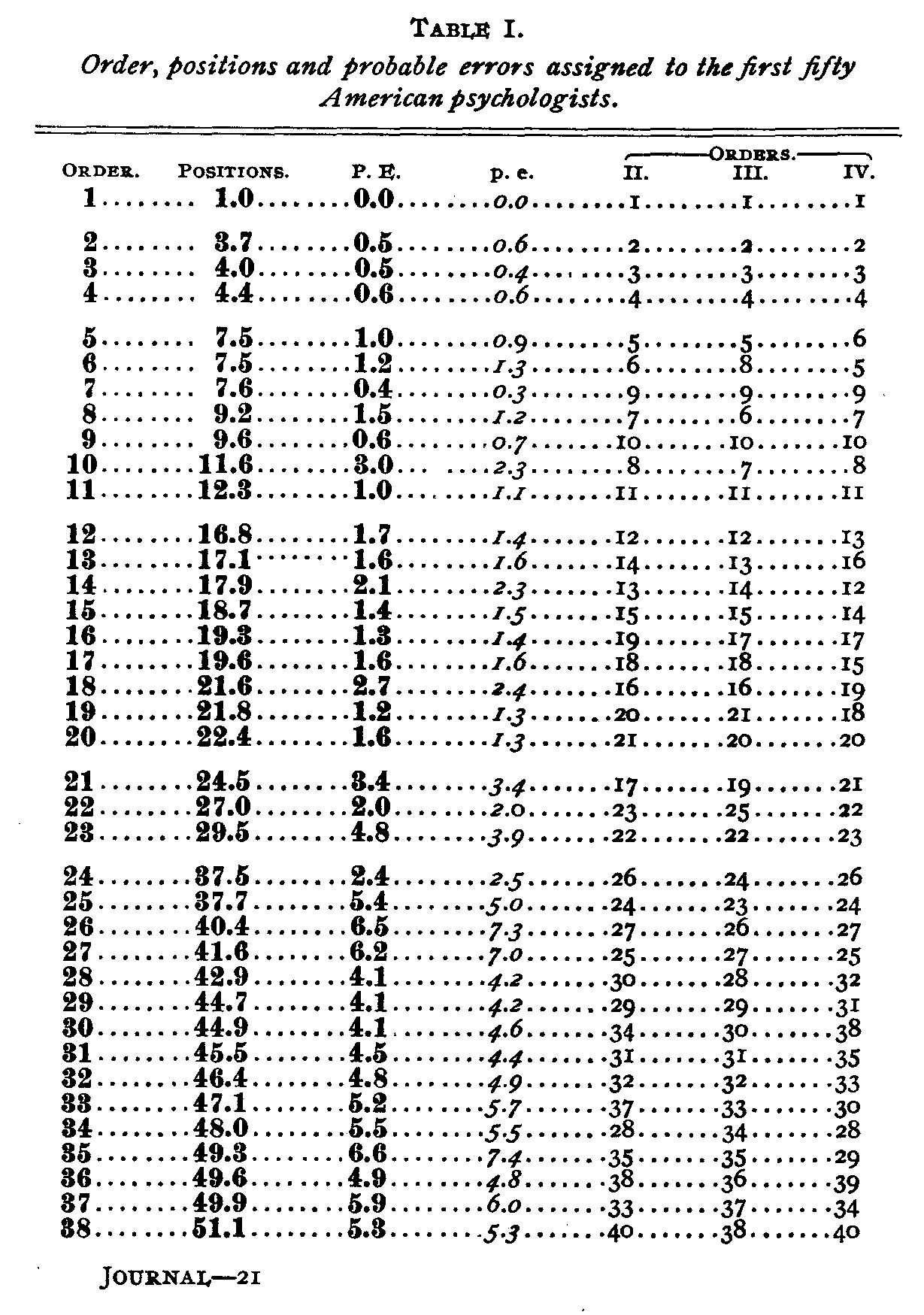
(578)
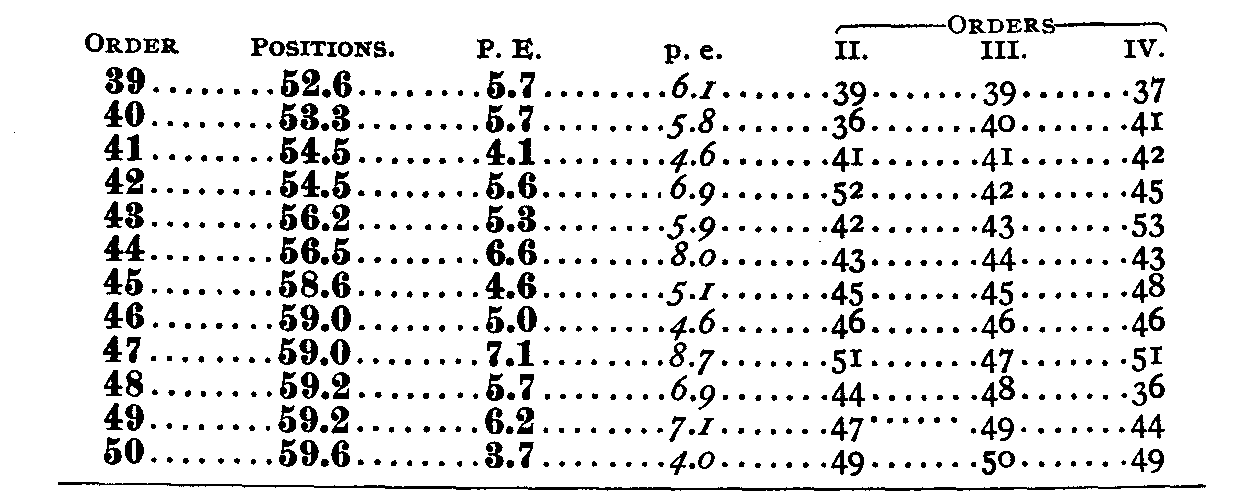
The table gives the results for the fifty psychologists esteemed the most meritorious. The first column, printed in heavy type, gives the serial order in which they stand, the second column the positions as deduced from the average of the ten arrangements, and the third column the probable errors of these positions. The four remaining columns give the probable error obtained by the easiest method, and the order when the figures are compiled in accordance with the different methods described below. It should be distinctly noted that these figures give only what they profess to give, namely, the resultant opinion of ten competent judges. They show the reputation of the men among experts, but not necessarily their ability or performance. Constant errors, such as may arise from a man's being better or less known than he deserves, are not eliminated. There is, however, no other criterion of a man's work than the estimation in which it is held by those most competent to judge. The posthumous reputation of a great man may be more correct than contemporary opinion, but very few of those on this list of psychologists will be given posthumous consideration. I am somewhat skeptical as to merit not represented by performance, or as to performance unrecognized by the best contemporary judgment. There are doubtless individual exceptions, but, by and large, men do what they are able to do and find their proper level in the estimation of their colleagues.
It will be noticed that the probable errors tend to increase from the top of the list downward. These errors show the validity of position and also the amount of difference between the men. No. 3, with a grade of 4 and a probable error of
( 579) 0.5, has about one chance in three of being higher than the grade of No. 2, or of being lower than that of No. 4. The chances are more than 10,000 to one that he is not as high as No. 1,1 or as low as No. 5. At the bottom of the list the probable errors show that the positions are probably correct within about ten places. The chances are about one in four that No. 40 does not belong among the first fifty psychologists.
The men at the top of the list differ much more from each other than the men at the bottom. The average probable errors of the first ten is less than one, and they cover a range of about ten points ; the average probable error of the last ten is about six, and they cover a range of about five points. If we may assume that the differences between the men are directly as the difference in grade and inversely as the probable error, there is about twelve times as much difference between the individuals near the top of the list as between those near the bottom. It is as easy for a man towards the bottom to gain twelve places in the estimation of his colleagues, as for a man near the top to gain one place. There is about as much difference between No. 1[4] and No. 2, as between No. 2 and No. 8, which again, is about equal to the difference between No. 24 and No. 50.[5]
The table indicates that the differences are not continuous, but that there is a tendency towards the formation of groups or species. This may be due to accidental breaks in the series, but similar breaks in approximately the same places occur in other sciences. Among the psychologists, and in several other sciences, there is one man who stands distinctly at the head, completely separated from those next to him. Should No. 1 die, his place would not be taken by No. 2, but Nos. 2, 3, and 4, and others would each be raised a little. This man is a great genius, who has an international, and will have a posthumous, reputation. Then, among the psychologists we have
( 580) a distinctly marked group of three ; they are men who doubtless have a reputation beyond their own science and their own country. There is next a group of seven, so well marked that it is very unlikely that any one of them belongs above or below this group. There is next an equally distinctly marked group of twelve. The break at the end of this group is eight whole points, and would be fifteen points did not the individual Nos. 21, 22, and 23 partly bridge it. Nos. 21 and 23 have comparatively large probable errors, and in my opinion belong to the upper group. No. 22 appears to me to belong to the upper group by ability, and to the lower group by performance, and will probably join later one or the other group. There is, consequently, a well-marked break separating the first 20 or 23 psychologists from those below. The chances are very great[6] against Nos. 19 or 20, being as low as the grade of No. 24. The break is also shown in the probable errors, which increase almost suddenly from about 2 to about 6. The average age of the group from No. 24 to No. 50, is 39.93 years, and of the group from No. 12 to No. 23, is 40 years. It appears to me that not more than three or four of those in the lower group will ever pass over to the upper group. There is about the same percentage further down in the second and third fifties who are nearly as likely to enter the first group. We thus seem to have two main groups or types ; the leaders, and the men of moderate attainments, the leaders being about one-tenth of the whole number. The leaders are again broken into four groups — say, of great genius, of moderate genius, of considerable talent, and of talent.[7] It appears that analogous groups are found in other sciences, and it is probable that they also exist in other lines of intellectual activity and performance.
The lower group, from 24 to 50, and on down to the end of the 200, shows no further break and no very great increase in
( 581) mediocrity. The group is heterogeneous and may be divided into three main subgroups — psychologists of moderate ability who have found their level ; young men who may improve their positions, even going to the top of the list; and students of other subjects, almost exclusively philosophy or education, who have made, or are supposed to have made, contributions to psychology.
In the average positions given in the table, the ten arrangements are included without omissions. Those who made the arrangements do not, however, possess equal information or judgment, and here again it is possible to measure traits that at first sight appear to be scarcely comparable. The table gives the average variation of the judgments of each observer from the average of the judgments of the ten observers. Data are given for groups of ten (I, the ten psychologists highest on Table I, etc.), which show a considerable degree of constancy.
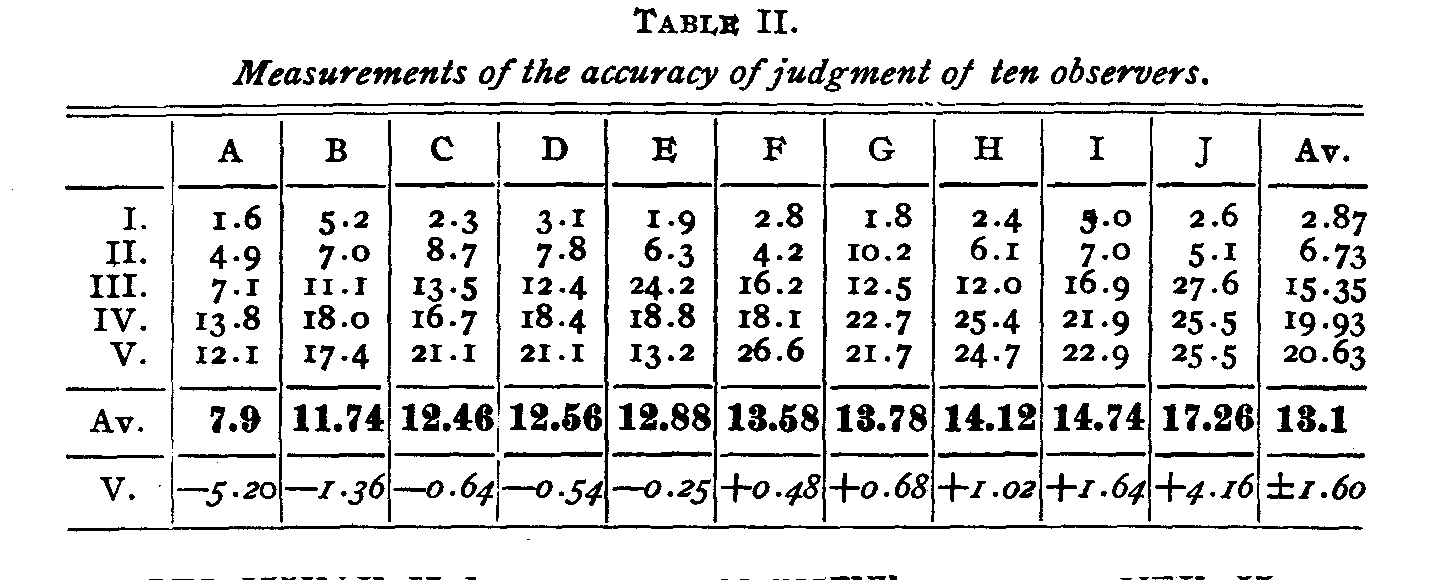
The observer A is always more accurate than any other observer, except in one case in fifty. The validity of judgement of the ten observers varies from 7.9 to 17.26, or about as 1:2, which is approximately the variability I have found in normal individuals in other mental traits, accuracy of perception, time of mental processes, memory, etc. The departures from the mean reliability of judgment, given in the last line of the table, indicate that accuracy of judgment tends in a general way to follow normal distribution of the probability curve. As the validity of the judgements vary to a measured degree, the arrangements made by the individuals should be weighted. I have not undertaken the somewhat
( 582) tedious calculations necessary; they would not considerably alter the order, but would make it somewhat more exact, at the same time decreasing the probable errors.
Taking the individual departures from the mean of the ten estimates in each case (the residuals or errors), and reducing them to a common standard, we secure the distribution of the 500'errors ' shown in the figure. The curve is fairly regular,
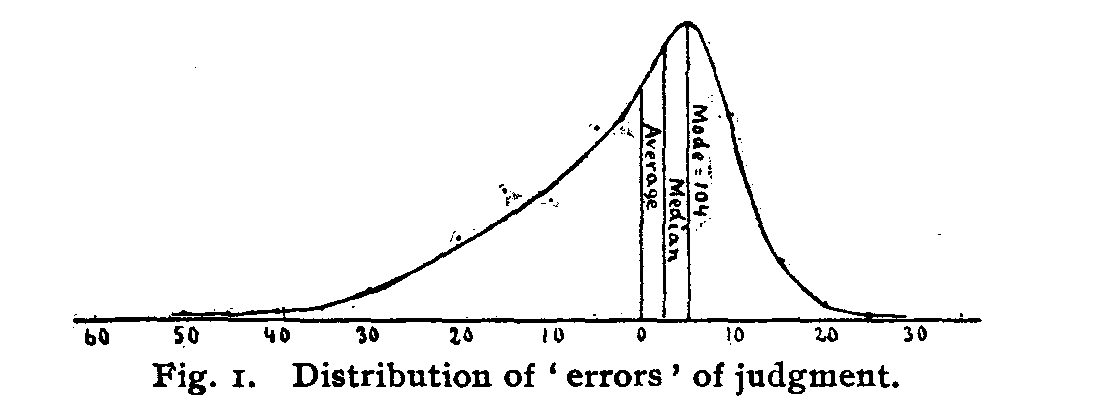
but asymmetrical. The judgments do not follow the distribution of the probability curve and do not represent the typical case of errors due to a large number of independent and small causes equally likely to be positive or negative. The average judgment would give a man a lower grade than the median judgment, and this again is lower than the mode or most common judgment. This means that in judging the position of a man, the individual judgments are more likely to depart considerably from the average in placing him too low than too high. This is especially the case for men near the top of the list. The judgments do not, however, depart abnormally from the mean. According to Chauvenet’s criterion, there should not be in 500 observations any over about five times the probable error. There are in this series but three departures larger than this, which all occur near the top of the list, and in the negative direction. The regular character of the curve seems to show that the extreme judgments are not abnormal. There is no evident group or species, due to ignorance, prejudice or the like, such as might conceivably have existed.
Under these circumstances, we may ask, what is the most probable position of the individuals? Should we take the average, median or mode, or possibly some compromise, such as would be obtained by omitting certain of the more divergent
( 583) judgments? It seems to me that any of these procedures would be correct, but that the meaning would be different in each case. The average is what it professes to be — the average judgment; here a single unfavorable judgment is more likely to be large than a favorable one, and a single judgment may pull a man down further than it can lift him up. The median is also what it professes to be — the middle judgment, omitting the divergent judgments and not taking into account the size of the departures. The mode, or most common judgment, comes out clearly as the result of 500 measures, but would not in the case of the ten judgments for each individual. It has seemed to me that in many psychological measurements, there is something to be said for a compromise between the average and the median.[8] The curve of distribution is usually asymmetrical, and the more divergent measures may be due to abnormal conditions. Experimenters have been led to reject observations that appeared to be abnormal, and have sometimes done so in a way that has invalidated their results. I can see no theoretical objection to a criterion such as Chauvenet's, or to the plan used by me of rejecting in each series a certain fixed number of the more divergent results, the average of the entire and of the corrected series being given. It is an advantage to do away with incorrect or even abnormal values in an objective manner, and so far as normal values are eliminated, we are simply adopting a compromise between the mean and the median.
In the case before us, the regular character of the curve of distribution and the fact that the departures are scarcely larger than the theory of probabilities would lead us to expect in the case of an orthodox distribution, show that the more divergent judgments are not abnormal. The most divergent errors were in the cases of Nos. 10 and 21, and it appears to me that there is some slight chance that each of these extreme judgments is correct — a larger chance, indeed, than the theory of probability indicates. On the other hand, the incidence of these extreme judgments on the individual seems unfair. If we had a hundred judgments of each individual, we might ex-
( 584) -pect one so divergent, but its effect would be nearly eliminated in the average. When a hundred judgments are given to ten individuals, we may expect that there is some slight chance that one of these individuals should be considerably lower than his grade indicates ; but the incidence on a particular individual seems to be a matter of chance. Thus, No. 10 is by a single divergent judgment carried down two places and given a probable error three times as large as he would otherwise have. The use of the median or the omission of the more divergent judgments by Chauvenet's criterion, or otherwise, tends to give most of the individuals a higher grade, but scarcely alters the position of any one beyond the limits already indicated by the probable error.[9]
I have used in my discussion the simple averages from all the judgments. In the table, however, is given the order of the individuals when the two highest and the two lowest judgments are discarded (Order II), when Chauvenet's criterion is approximately applied[10] (Order III), and when the median is taken (Order IV).
A careful consideration of the individual figures leads me to believe that the use of all the judgments is quite satisfactory, the exceptional judgments not altering the positions to a considerable extent, or beyond the limits of the probable errors except in one case. I am inclined to believe, however, that the most valid order is that in which the six most accordant judgments were used, and the order next in validity is that in which Chauvenet's criterion is applied.[11] The median seems
( 585) to be the least satisfactory determination, as, owing to the comparatively small number of observations, the position is determined by chance.
There are given two probable errors. The former (P. E.), has been deduced by way of the squares of the residuals, the latter (p. e.) by multiplying the mean variation by 0.28.[12] There is really but little difference in the results, and in view of the character of the curve of distribution, I doubt whether this is significant. It seems to me to be a waste of time to use the method of least squares in such cases.
The curve of distribution of the men on the list approaches roughly the distribution of the probability curve at the positive end. We have, as a matter of fact, only fifty psychologists on the table given above, and if we assume that all the psychologists of the country form a ` species,' we have only the upper fourth or fifth of the distribution. On the average about one hundred psychologists were arranged in the order of merit by the ten observers, but the number varied from 53 to 175. I have counted out the order and the probable errors up to 120 places, but after about 75 places they have not much validity. When an individual was not included on one of the lists, he was given a grade about midway among those omitted ; but this procedure is inexact and tends to decrease unduly the probable errors. It would be of interest to secure the complete curve of distribution, but it is scarcely possible to do this, as the men in the lower half are not known to those who make the arrangements. In this case the sizes of the probable errors depend on the ignorance of the observer as well as on the similarity in merit of the men. I am myself fairly well acquainted with the work of our minor psychologists. When I undertake to rearrange the men, there is but little variation in the position of those near the top of the list, while the variations increase constantly as I go downward. Ten arrangements made by the same individual, would give an order and probable errors analogous to those of the table, but this is an experiment that cannot be made accurately, as the observer remem-
( 586) -bers his previous arrangements, thus introducing a large constant error. I, however, regard my own judgment as subject to a probable error somewhat similar in size to that given in the table as deduced from ten observations. This subjective probable error increases continuously as I go down the list, and I assume that there is no descending half on the negative side of the curve of distribution. Starting from the median man there is a rough approximation to the probability curve on the positive side, but on the negative side the curve continues to rise, but with increasing slowness. This refers to the great majority of those on the negative side of the median, their work being simply mediocre or unimportant. There are, however, a few individuals in each science whose work is inaccurate or bad. They belong to a different `species,' and are scarcely comparable with the others. There would be some agreement as to their order, and they would form a descending curve. They are, however, far too few to balance those above the median. It should be noted that while for men whose work is well known the order and probable errors nearly coincide with their performance and ability, in the case of men who are imperfectly known, the probable errors are a function of this ignorance. If the men below the median were as well known as those above, the probable errors might not continue to increase as we go down. Among my students those weak in psychology do, in a general way, seem to balance those who are good, in accordance with the distribution of the probability curve. But the students on the minus side do not become professional psychologists. However, even if we assume that all the people of the country are psychologists of a sort, their distribution seems to be represented more nearly by the positive half of the probability curve than by the whole curve.
It is claimed by Mr. Galton and others that the probability curve represents the normal distribution of ability, the idiots balancing the geniuses, etc. But I am not sure that this is correct. For example, it seems to me that in poetic ability the great poets differ fully as much from the poor poets, as these do from the mass of mankind, and that the latter do not differ so much among themselves in poetic ability as do poets. Poetic ability would thus be distributed as suggested for psycho-
( 587) -logical ability. Ability and performance may not be due to a large number of small causes equally likely to be positive or negative, but there may be a certain standard ability which may be increased by a few relatively large causes, hereditary and environmental, but not correspondingly decreased.
It is my intention to make a somewhat elaborate study of the natural history of American men of science. I am at present, however, only able to give in regard to the psychologists some statistics of their academic origin, course and destination. The accompanying table contains data regarding the education of the two hundred psychologists. There are given the numbers that took the A.B. or equivalent degree from various institutions, the numbers that pursued graduate studies without taking the doctor's degree at the given institution, and the numbers that were given the doctor's degree. Institutions are included that were attended by three or more students. Most of those who took the bachelor's degree pursued graduate studies, and they may be entered in the three different divisions. Those who took the doctor's degree were also graduate students at the institution granting it, but they are not entered under this heading in the table. Many pursued graduate studies at two or more universities and are included under each. There are consequently duplications in the second division, but not in the first or third. When a man has taken a bachelor's degree from more than one institution, he is credited to the first, and if the work at the second was specialized he is credited as a graduate student. The spirit rather than the letter of the classification has thus been followed. Each division of the table is divided into four columns, numbered I, II, III, IV, under which are the figures for the four groups into which the men have been classed, the fifty selected as the best being in the column under I, etc.
The most interesting fact shown by the tabulation appears to be the very large number of institutions—seventy-six—from which the 200 psychologists have come. The origin of the men is in general independent of the college at which they were educated, as is also their rank among psychologists. Harvard, with its strong department of philosophy and psychology, has not produced three times as many psychologists as
( 588)
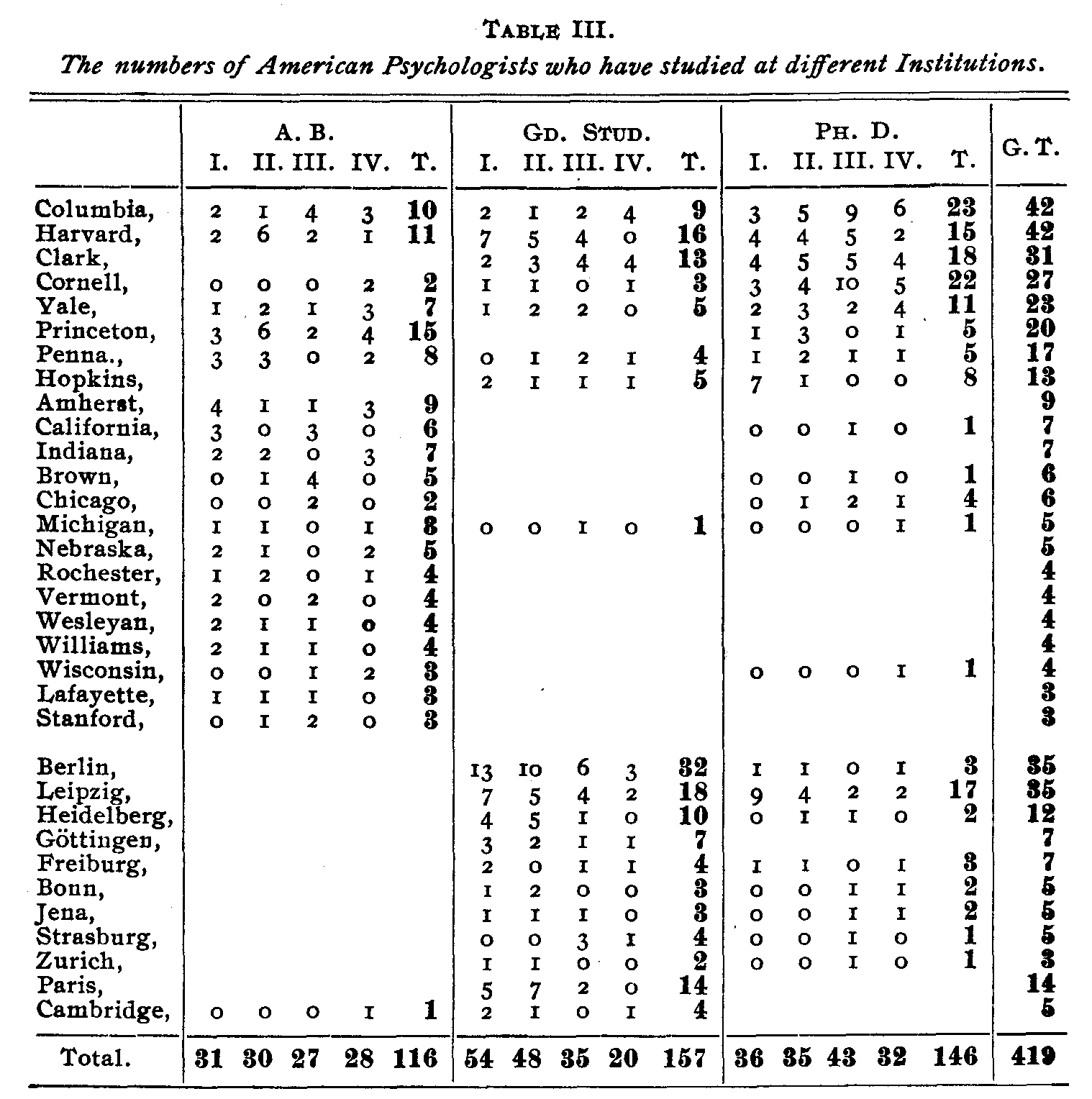
Rochester, Vermont, Wesleyan, or Williams, though it has given its Bachelor's degree to far more than three times as many students. Yale, where philosophy and psychology have been required studies under able professors, has not produced twice as many psychologists as each of the colleges mentioned. Cornell has only produced half As many. Of the eleven psychologists from Harvard, only two are in the first fifty, and of the seven from Yale, only one. Some institutions have produced more than their share of psychologists, as Indiana and
( 589) California, but probably not more than the theory of chance distribution would lead us to expect, except in the cases of Princeton and Amherst. At these two colleges there appears to be an influence strong enough to direct men to psychology.
There is, perhaps, no other information so desirable for applied psychology and sociology as knowledge of the extent to which the performance in life of the individual is due to what Mr. Galton has called nature and nurture, respectively. Our present knowledge is scanty and ambiguous, so that it is possible to hold extreme views without coming into conflict with facts. It may plausibly be argued that a man's career is chiefly prescribed by his equipment at birth, or chiefly by his environment, education, and opportunity. It appears to me that certain aptitudes, as for music, mathematics, etc., are chiefly innate, and that kinds of character and degrees of ability are largely innate. But I have been inclined to believe that the direction of performance was largely determined by circumstance, that a man who is a psychologist might, by a comparatively slight and accidental alteration in conditions, have become a zoölogist, or a lawyer, or a man of business, and have been almost equally successful in any career. This view seems to me, however, to be traversed by these statistics, which, as far as they go, indicate that psychologists are born, not made.
After the men have graduated from college, and when their work has been chosen, they are gathered for their special studies into a few universities. It does not seem, however, that they are turned into psychologists at these universities. They simply select for study the universities that have reputation and facilities, being often attracted by fellowships or the hope that the university will assist them in securing positions. The direction of the work is sometimes determined or influenced by the university, the merit of the work but slightly, if at all. Harvard, Clark, Columbia, Cornell, and Yale have contributed to the first group 4, 4, 3, 3, 2 doctors, respectively, and to the second group, 4, 5, 5, 4, 3.There are relatively more men in the third and fourth groups from Columbia and Cornell, which is in part due to the fact that Columbia has conferred the degree frequently in education, and Cornell in philosophy, and
( 590) the men being ranked for their contributions to psychology come in the lower hundred. It should also be stated that my returns for Columbia are probably more complete than for the other universities. This would not affect the first hundred, but the total influence of Harvard shown by my statistics to be equal to that of Columbia, is probably somewhat greater. Harvard, Clark, and Columbia have had, according to the table, almost exactly the same number of graduate students ; if, however, we add together the students under President Hall at the Johns Hopkins and Clark Universities, they surpass in numbers and in rank those of any other institution.
It will be noted that our psychologists have studied in Germany in large numbers, no less than thirty-five, both at Leipzig and at Berlin. Leipzig has exerted much the greater influence, having conferred seventeen doctorates on men who studied there from one to five years. Men record themselves as having pursued graduate studies at German universities when the time was a semester or less, whereas here it is practically always at least one year. It is noticeable that more men of the first group have studied and taken their degrees in Germany, and that the numbers decrease as the groups become lower. I should not interpret this as meaning that men are made better psychologists by going to Germany. Men of greater ability and enterprise are perhaps more likely to go to Germany, but the facts of the table are largely due to the circumstance that the older men have studied in Germany in much larger numbers than those who are younger.
The two hundred psychologists come originally from 76 institutions, they gather together for graduate study at a comparatively small number of universities, and are again widely dispersed. Nearly all the men are engaged in teaching, being distributed among 57 colleges and universities, 14 normal schools, and six other schools. There is, indeed, not a single person on the list who has not been engaged in teaching, though three or four have, only given lecture courses incidentally. There are at present only eight who do not earn their livings by teaching or administrative educational work. I can give in quantitative terms the strength of the work in psychology in different institutions, but it may be wiser to postpone
( 591) publication of the figures until all the sciences can be treated together.
It is fortunate for psychology that there are in this country so many teaching positions to be filled. Still, the conditions present certain serious drawbacks. The time of the men is occupied in teaching, and in administrative, clerical, or missionary work, which, together with their great dispersal, is not favorable to the cultivation of a spirit of scholarship and research. There is but small opportunity for natural selection, a kind of panmixia obtaining. In other sciences larger numbers of men are needed for school work, and from these the better can be selected for the college and university positions. In most sciences there is applied work, into which those who prove inept for research can overflow.
It appears to me that psychology in America has received fewer contributions from those not professionally engaged in teaching it than is the case in other countries. In Great Britain there has always been a group of men, largely selected from the wealthy classes, who have not earned their livings by teaching, but have devoted themselves to research and authorship. Psychology in Germany has received important and numerous contributions from physiology, physics, neurology, and other sciences to an extent not approached in America.
In order to compare our productivity with that of other nations, I have counted up the first thousand references in the index to the twenty-five volumes of the Zeitschrift fur Psychologie. These are the papers published in, or reviewed by, the journal, and are doubtless supposed to be the more important contributions to psychology. In the table are given the numbers of contributions from each nation and a classification of the subject-matter. Germany leads in productivity, though German contributors are favored in the original articles and also in the reviews of the Zeitschrift. This appears to be especially the case under the heading `Physiological' (which includes pathological and physical papers). The French experimental papers include 48 by M. Binet, and if the classification had been carried to the end of the alphabet, the French contributions would have been relatively much fewer. I should infer from the table that America leads decidedly in experimental con-
( 592)
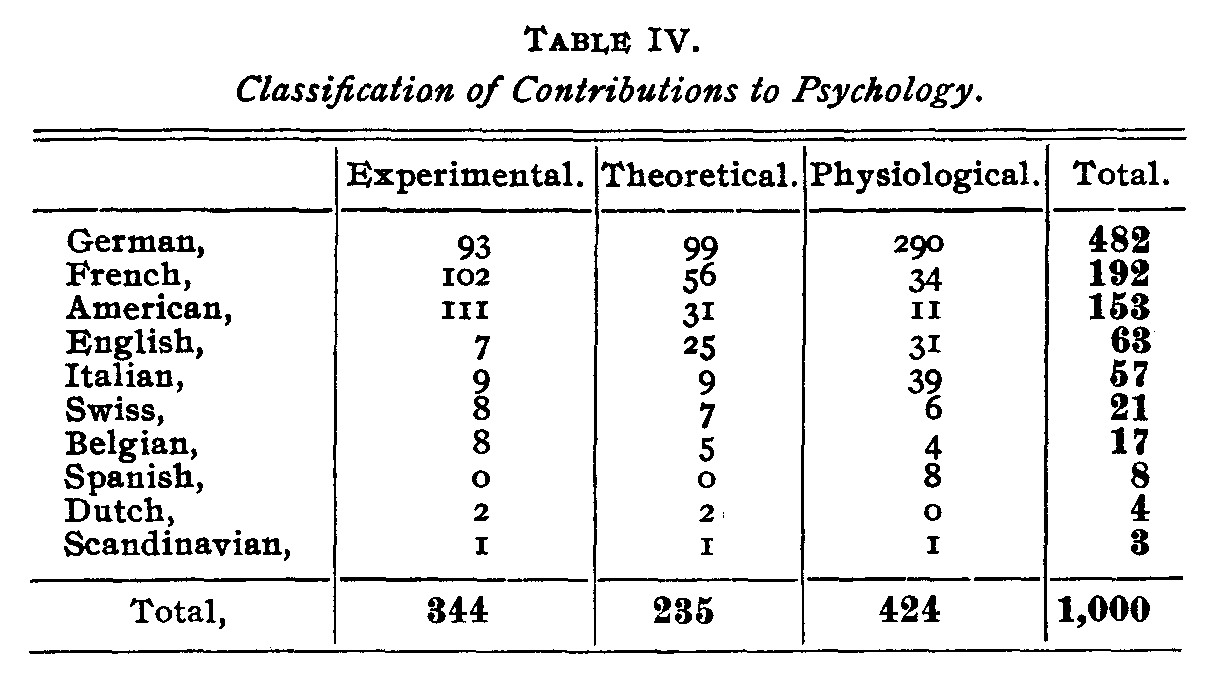
-tributions to psychology, that we are about equal to Great Britain in
theoretical contributions, but are almost doubled by France and Germany, and
that we are decidedly inferior to Germany, France, Great Britain, and Italy in
contributions of a physiological and pathological character. The thousand
contributions counted up extend into the F's or to rather more than one-fourth
of the index. Thus, somewhat less than six hundred American contributions in the
course of ten years have been published in, or reviewed by, the
Zeitschrift. There were not, during this period, as many as two hundred
American psychologists. But in a general way it appears that each of our
psychologists has on the average made a contribution of some importance only
once in two or three years.